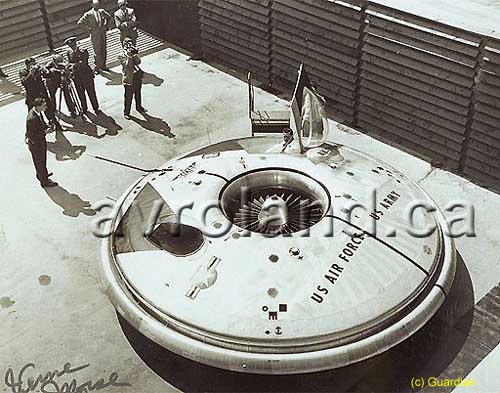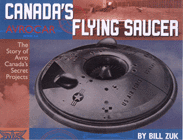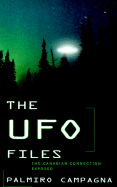      |

Dedicated to the people and projects of AVRO Canada & Orenda Engines Limited
AVROCAR (the only official "flying saucer")

In 1952, Avro Canada began to study designs for a supersonic cirular wing fighter-bomber, this was funded by the Canadian government with $400,000 allocated. After the $400,000 ran out the Canadian government abandoned the project as being too costly, however enough progress had been made to spark the interest of the U.S. governement.
In July 1954, the first of two U.S. Air Force contracts totaling $1.9 million was awarded to Avro for further study, Avro chipped in $2.5 million and completed design studies and small scale test on a vehicle designated the P.V. 704 (U.S. designation, System 606A). The 606A design was almost 30 ft. in diameter with a maximum weight of 27,000 lbs and a design speed over 1,000 mph.
The U.S. Army became interested in the project in 1958, feeling that the circular wing could fit in with its plans for a "flying jeep", the Air Force agreed to redirect its effort as this could demonstrate the design features of the 606A concept in less time at a must lower price.
The resulting craft was named Avrocar and given the Army designation VZ-9AV (VZ for vertical take-off reseach aircraft, 9 as it was the ninth in a series and AV for Avro)
The Avrocar was a saucer-shaped disk 18 ft in diameter and 3 ft thick, it was designed to go 300 mph and able to fly to an altitude of 10,000 ft. It weighed 5,650 lbs and had separate cockpits for two crew members.
Three Continental J-69 turbojet engines powered a centrally located fan with a diameter of 5 feet.
Two prototypes rolled out of the factory in May and August of 1959 just months after the Arrow project had been cancelled. The first Avrocar (58-7055) was sent to NASA Ames, Moffett Field in California it first flew there on 17 May 1961 and was used for wind-tunnel testing. The second Avrocar took first tethered flight on 29 September 1959 lasting 12 seconds. The first untethered flight occured on 12 November 1959. Formal Air Force flight evaluations occured at Avro in April 1960 and June 1961 - tests showed that the maximum speed was 35 mph and reseach at NASA showed that the Avrocar was aerodynmically unstable.
The program was terminated in December 1961 after a total of $10 million had been spent. At Avro (U.K.) project 724 never proceeded beyond the designs stage in June 1953.
From Aircraft Magazine - October 1962:
The prototype of the vehicle which at one stage gave the Canadian aircraft industry good promise of a major breakthrough in VTOL is today collecting dust in a hangar of the National Aeronautics and Space Administration's Ames Research Centre at Moffett Field, Calif. Word from the Centre's chief of flight and systems simulation is that no further flight tests are planned with the Avrocar, once regarded as the most advanced and most promising project in the application of ground-effect to development of a pure jet VTOL vehicle. The "Saucer" is reported to have performed well within its ground-effect envelope, but was unstable above about three feet. Initiated by Avro Aircraft, the "Saucer" project was taken over by the U.S. government after Canadian Government support was withdrawn in 1954. A post-mortem on the Avrocar is offered by pilot Fred J. Drinkwater III, a research engineer: "All the new flying concepts are cans of worms at the early stage. Tests showed the saucer would have taken too much more development effort. Other concepts proved more promising".
The two prototypes are currently in the United States, on at the US Army Transportation Museum and the other is at the Smithsonian NASM Garber site
A unique note of trivia for you is that the registered owner of the Avrocar was the U.S. Government
and registration was CF-LWV-X.
Check out
your local book store for Bill Zuk's book
Avrocar: Canada's Flying Saucer: The Story of Avro Canada's Secret Projects
it may be ordered online from Chapters.ca (ISBN1-55046-359-4)


For photos of the VZ-9AV check out the Canadian National Aviation Museum